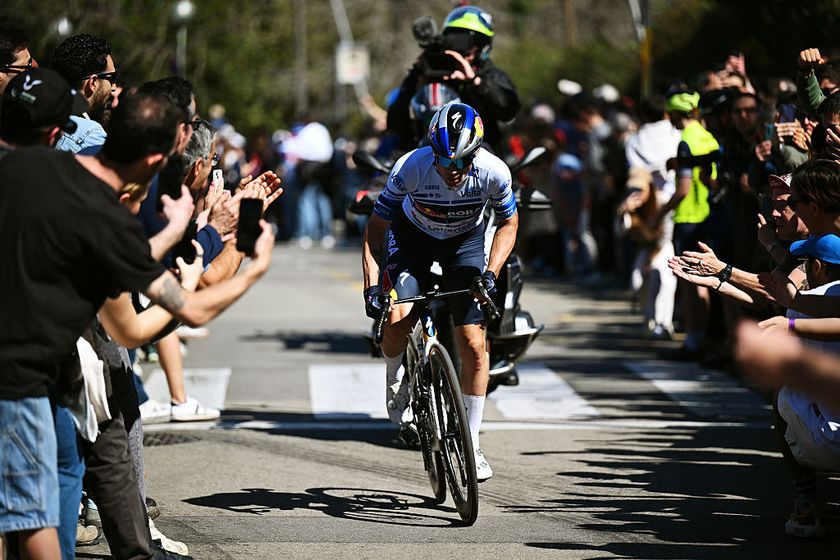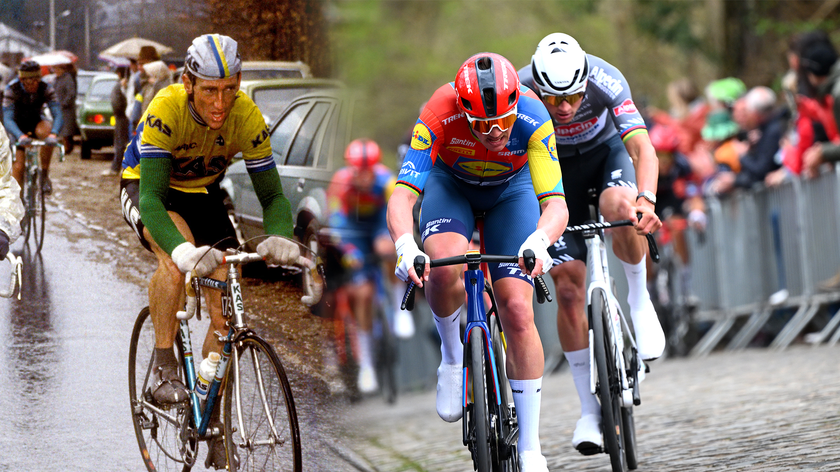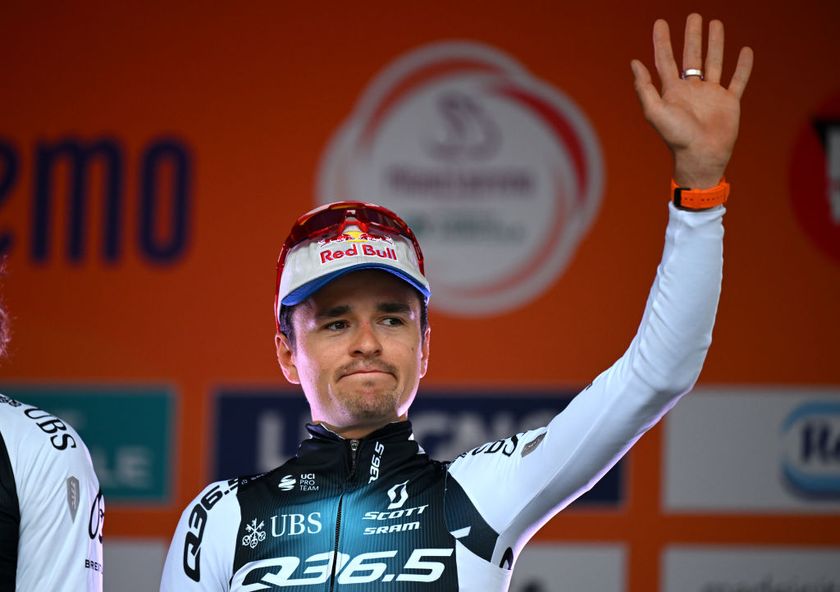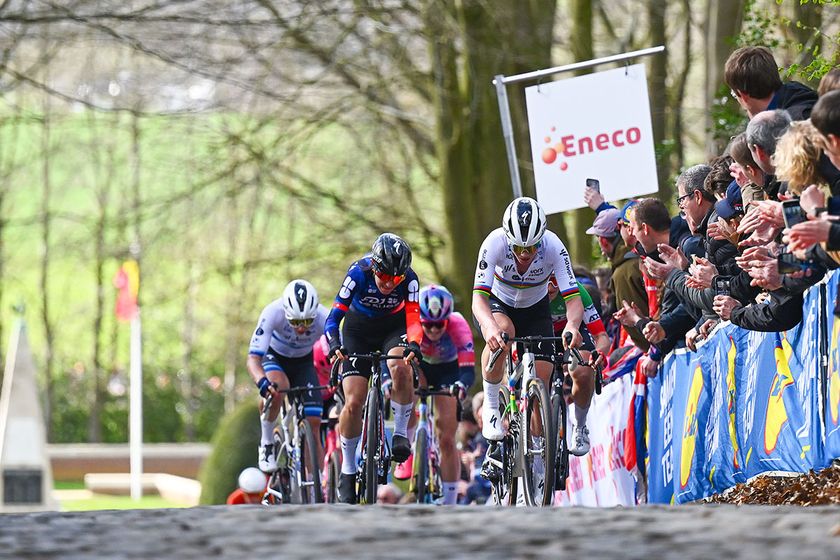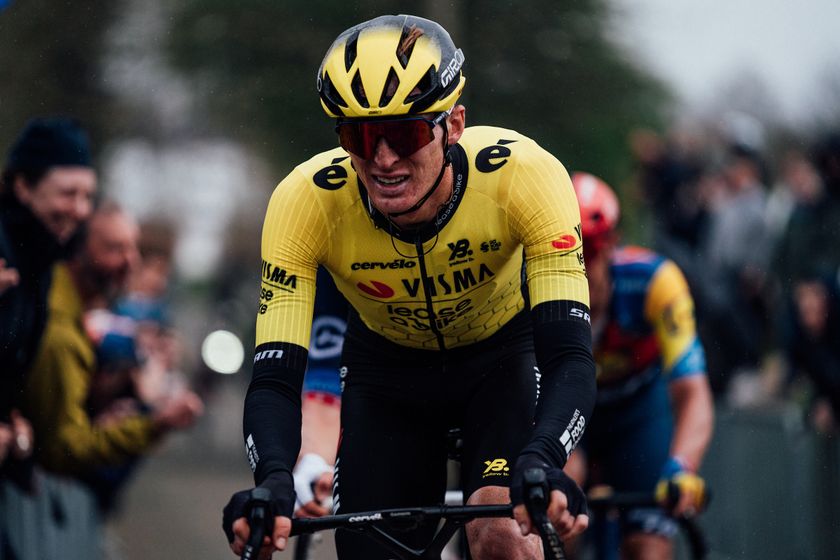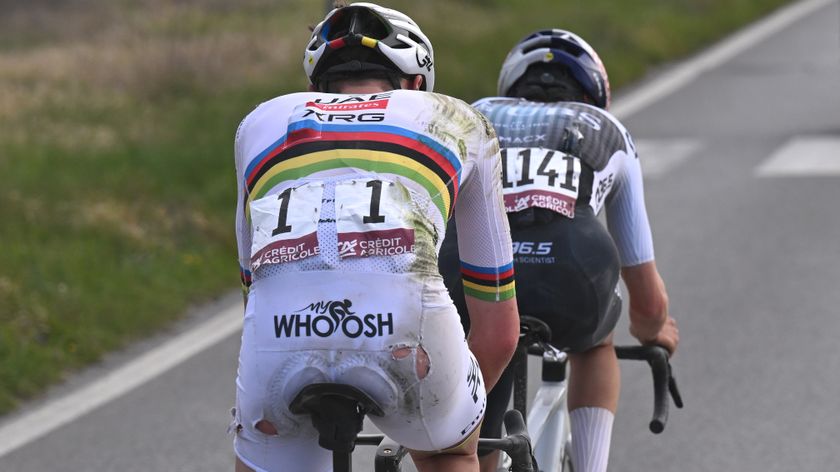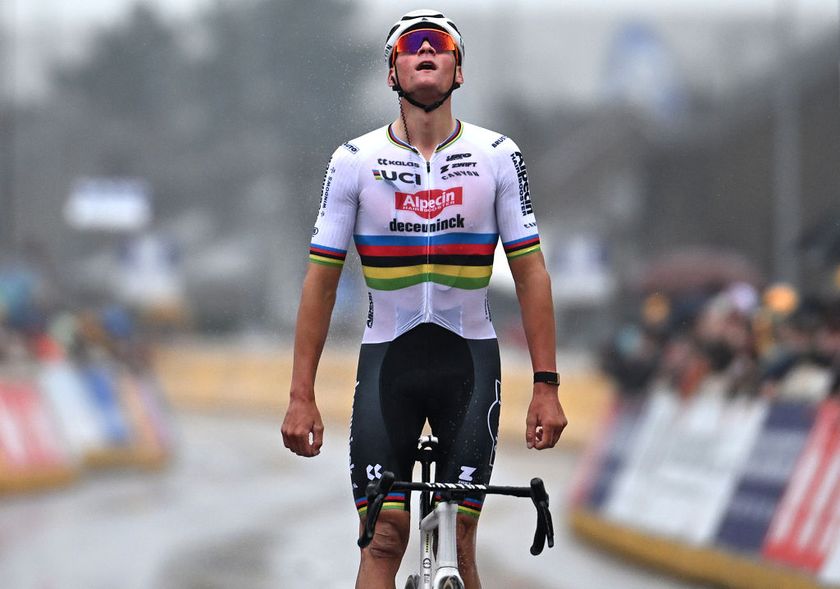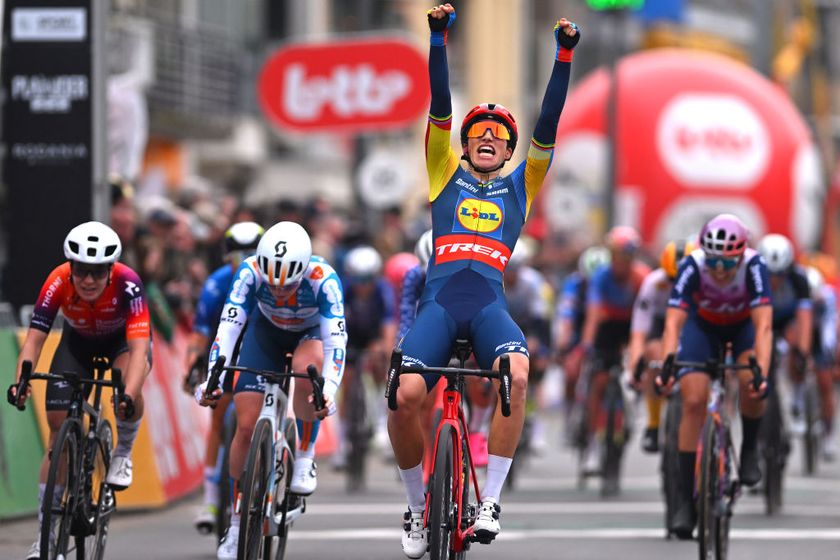Fitness questions and answers for July 31, 2007
Got a question about fitness, training, recovery from injury or a related subject? Drop us a line at...
Form & Fitness Q & A
Got a question about fitness, training, recovery from injury or a related subject? Drop us a line at fitness@cyclingnews.com. Please include as much information about yourself as possible, including your age, sex, and type of racing or riding. Due to the volume of questions we receive, we regret that we are unable to answer them all.
Carrie Cheadle, MA (www.carriecheadle.com) is a Sports Psychology consultant who has dedicated her career to helping athletes of all ages and abilities perform to their potential. Carrie specialises in working with cyclists, in disciplines ranging from track racing to mountain biking. She holds a bachelors degree in Psychology from Sonoma State University as well as a masters degree in Sport Psychology from John F. Kennedy University.
Dave Palese (www.davepalese.com) is a USA Cycling licensed coach and masters' class road racer with 16 years' race experience. He coaches racers and riders of all abilities from his home in southern Maine, USA, where he lives with his wife Sheryl, daughter Molly, and two cats, Miranda and Mu-Mu.
Kelby Bethards, MD received a Bachelor of Science in Electrical Engineering from Iowa State University (1994) before obtaining an M.D. from the University of Iowa College of Medicine in 2000. Has been a racing cyclist 'on and off' for 20 years, and when time allows, he races Cat 3 and 35+. He is a team physician for two local Ft Collins, CO, teams, and currently works Family Practice in multiple settings: rural, urgent care, inpatient and the like.
Fiona Lockhart (www.trainright.com) is a USA Cycling Expert Coach, and holds certifications from USA Weightlifting (Sports Performance Coach), the National Strength and Conditioning Association (Certified Strength and Conditioning Coach), and the National Academy for Sports Nutrition (Primary Sports Nutritionist). She is the Sports Science Editor for Carmichael Training Systems, and has been working in the strength and conditioning and endurance sports fields for over 10 years; she's also a competitive mountain biker.
Eddie Monnier (www.velo-fit.com) is a USA Cycling certified Elite Coach and a Category II racer. He holds undergraduate degrees in anthropology (with departmental honors) and philosophy from Emory University and an MBA from The Wharton School of Business.
Eddie is a proponent of training with power. He coaches cyclists (track, road and mountain bike) of all abilities and with wide ranging goals (with and without power meters). He uses internet tools to coach riders from any geography.
Get The Leadout Newsletter
The latest race content, interviews, features, reviews and expert buying guides, direct to your inbox!
David Fleckenstein, MPT (www.physiopt.com) is a physical therapist practicing in Boise, ID. His clients have included World and U.S. champions, Olympic athletes and numerous professional athletes. He received his B.S. in Biology/Genetics from Penn State and his Master's degree in Physical Therapy from Emory University. He specializes in manual medicine treatment and specific retraining of spine and joint stabilization musculature. He is a former Cat I road racer and Expert mountain biker.
Since 1986 Steve Hogg (www.cyclefitcentre.com) has owned and operated Pedal Pushers, a cycle shop specialising in rider positioning and custom bicycles. In that time he has positioned riders from all cycling disciplines and of all levels of ability with every concievable cycling problem.They include World and National champions at one end of the performance spectrum to amputees and people with disabilities at the other end.
Current riders that Steve has positioned include Davitamon-Lotto's Nick Gates, Discovery's Hayden Roulston, National Road Series champion, Jessica Ridder and National and State Time Trial champion, Peter Milostic.
Pamela Hinton has a bachelor's degree in Molecular Biology and a doctoral degree in Nutritional Sciences, both from the University of Wisconsin-Madison. She did postdoctoral training at Cornell University and is now an assistant professor of Nutritional Sciences at the University of Missouri-Columbia where she studies the effects of iron deficiency on adaptations to endurance training and the consequences of exercise-associated changes in menstrual function on bone health.
Pam was an All-American in track while at the UW. She started cycling competitively in 2003 and is the defending Missouri State Road Champion. Pam writes a nutrition column for Giana Roberge's Team Speed Queen Newsletter.
Dario Fredrick (www.wholeathlete.com) is an exercise physiologist and head coach for Whole Athlete™. He is a former category 1 & semi-pro MTB racer. Dario holds a masters degree in exercise science and a bachelors in sport psychology.
Scott Saifer (www.wenzelcoaching.com) has a Masters Degree in exercise physiology and sports psychology and has personally coached over 300 athletes of all levels in his 10 years of coaching with Wenzel Coaching.
Kendra Wenzel (www.wenzelcoaching.com) is a head coach with Wenzel Coaching with 17 years of racing and coaching experience and is coauthor of the book Bike Racing 101.
Steve Owens (www.coloradopremiertraining.com) is a USA Cycling certified coach, exercise physiologist and owner of Colorado Premier Training. Steve has worked with both the United States Olympic Committee and Guatemalan Olympic Committee as an Exercise Physiologist. He holds a B.S. in Exercise & Sports Science and currently works with multiple national champions, professionals and World Cup level cyclists.
Through his highly customized online training format, Steve and his handpicked team of coaches at Colorado Premier Training work with cyclists and multisport athletes around the world.
Brett Aitken (www.cycle2max.com) is a Sydney Olympic gold medalist. Born in Adelaide, Australia in 1971, Brett got into cycling through the cult sport of cycle speedway before crossing over into road and track racing. Since winning Olympic gold in the Madison with Scott McGrory, Brett has been working on his coaching business and his www.cycle2max.com website.
Richard Stern (www.cyclecoach.com) is Head Coach of Richard Stern Training, a Level 3 Coach with the Association of British Cycling Coaches, a Sports Scientist, and a writer. He has been professionally coaching cyclists and triathletes since 1998 at all levels from professional to recreational. He is a leading expert in coaching with power output and all power meters. Richard has been a competitive cyclist for 20 years
Andy Bloomer (www.cyclecoach.com) is an Associate Coach and sport scientist with Richard Stern Training. He is a member of the Association of British Cycling Coaches (ABCC) and a member of the British Association of Sport and Exercise Sciences (BASES). In his role as Exercise Physiologist at Staffordshire University Sports Performance Centre, he has conducted physiological testing and offered training and coaching advice to athletes from all sports for the past 4 years. Andy has been a competitive cyclist for many years.
Michael Smartt (www.cyclecoach.com) is an Associate Coach with Richard Stern Training. He holds a Masters degree in exercise physiology and is USA Cycling Expert Coach. Michael has been a competitive cyclist for over 10 years and has experience coaching road and off-road cyclists, triathletes and Paralympians.
Kim Morrow (www.elitefitcoach.com) has competed as a Professional Cyclist and Triathlete, is a certified USA Cycling Elite Coach, a 4-time U.S. Masters National Road Race Champion, and a Fitness Professional.
Her coaching group, eliteFITcoach, is based out of the Southeastern United States, although they coach athletes across North America. Kim also owns MyEnduranceCoach.com, a resource for cyclists, multisport athletes & endurance coaches around the globe, specializing in helping cycling and multisport athletes find a coach.
Crash into the back of an SUV
Road rash
Geting going?
Numb toes
Knee + hips + endless fit struggles
Concerns about the chocolate milk study
Knee Pain
Crash into the back of an SUV
I am a 23 year old male category 4 racer living in South Carolina. I was riding down a fairly busy street and was in the right most lane that was turning left onto another road. As I went through a light two cars passed me (I was probably going 15-20 mph). As I was accelerating out of the turn, a car up the road slowed to turn and all the cars in front of me stopped.
Unfortunately I could not stop quickly enough and ran into the back of one of the cars that had just passed me. This happened maybe 100 ft after the turn.
I put some pretty good dents in the tailgate of the SUV directly in front of me and ended up with a few scratches and bruises. My real question is who is at fault here? Is it my fault that I could not slow down quickly enough, or, should drivers give cyclists enough room to ride without this type of scenario?
I feel like I was travelling at a reasonable speed to keep up with traffic (20mph), however at that speed I wasn't allowed enough room to come to a complete stop. The driver ended up getting my information and said he might call to discuss repairs.
I just wanted to know what my legal situation was and whether or not I am actually at fault. We also didn't file an incident report if that makes any difference. Thanks for the advice.
Brantley Turner
Scott Saifer replies:
Unfortunately, you are most likely at fault. In general, the driver or rider in the back is at fault if he or she hits a slower moving vehicle in front.
Road rash
I have a question for your panel that (unfortunately) must have seen a lot of what is ailing me at the moment, road rash. Yes, I got in a spectacular crash over the weekend and am missing skin in loads of places.
Does anyone have advice on the best method/products to get healed up quickly? I'm just keeping everything moist with Neosporin and waiting it out. At what point should I let everything dry out? I've been showering every morning (OUCH!) and it definitely hurts like you wouldn't believe, but I'm concerned that showering may be increasing chances of infection.
Scott
Carrie Cheadle replies:
I hear that Tagaderm works well. My husband says "Put it on and don't touch it. It gets pretty gross, but don't touch it."
Geting going?
Last week you responded to a letter from a reader about feeling exhausted. Does this mean that you can go anaerobic at a low HR? One example would be where as you warm up, your HR stays low, but you push hard on a steep climb - you are placing energy demands on your muscles that they can't meet through aerobic metabolism but you are way below your anaerobic threshold in terms of HR. What is the effect of this in terms of depletion of muscle glycogen, production lactate and bicarbonate buffering? Are you burning through more of your "matches" than if you go anaerobic after reaching the top end of energy production when you are at the max of aerobic capacity?
Jason Rita
Scott Saifer replies:
Yes, you can "go anaerobic" at a low heart rate as you suggest. In fact, if you completely occlude blood flow, you can "go anaerobic" without even doing significant work.
Numb toes
I was wondering if Steve Hogg has somebody in Western Australia that supports your cyclefit arrangements. I have only been riding for just two years and I really enjoy a good hard ride. I train with several groups and at this stage I can push myself for a hundred kilometers.
I would like to be able to top out at two hundred per ride. I am 58 years old and retired. Three of my toes on my left foot go numb, the smallest toe as well as the next two, the other two are fine. It is not enough to stop me riding but it is quite annoying.
I have been to a foot podiatrist whom had a pair of inserts manufactured to correct my feet due to me not walking correctly. He said that this should also correct the numb toe situation. I have been wearing the inserts for a month in my Sidi cycle shoes.
As this has never happened before, I can only assume that it is my riding position that is causing this. At this stage of my life I have become really active in a number of sports to keep myself going. I have full fusion of the fourth and fifth lower lumber, also, two years ago due to restricted circulation in my arms I had two 230mm titanium rods inserted in my neck.
I ride five days a week, alternating a weight workout with a body press workout every other week as well as a full program of stretches.
I used to scuba dive six to eight times a week but due to some complications I was advised to stop immediately. I took up riding shortly after that.
I was thinking that cyclefit would maybe correct the issue I am having with my cleat or seat position, could you advise as to what may be causing the problem.
Phillip Cass
Steve Hogg replies:
Your problem could be the result of a number of things:
Knee + hips + endless fit struggles
I am attempting to get back into road racing for the third time; unfortunately this time is no different from the last. I simply cannot get comfortable on the bike. I'm a category 3 road racer in the USA, 5'11", inseam about 32 inches, shoes size 44, 160 lbs, and fairly flexible.
A bit of history - my first road bike for racing was a Bontrager Road Lite that was roughly a 55 cm top and seat tube (effective, since it had a sloping top tube). This was back in 1998. That bike was the last time I felt "perfect", but it got wrecked in a conflict with an SUV that decided to hit me. All I know about my fit back then was that my tibial tuberosity was roughly 1.5 cm behind the pedal axle of my Shimano SPD pedals.
My right knee always swung pretty far to the inside on every downstroke under hard efforts, but the bottom bracket was pretty wide, so I never hit the top tube. My heels both liked to be pretty far in (toes out), but didn't hit the chainstays (although close).
So, the driver of the SUV cut me a check and I got a Bianchi EV2, 57 cm, Look 247's with the red cleat, Sidi Genius 4's. I was re-fitted by the bike shop, who recalled that I liked to be a bit behind the axle, and we used the fit kit cleat adjustment tool that has two sticks out the side. I raced, was upgraded twice, and did quite well, but my right knee never felt quite right. I always had a twinge on the medial side, above the knee, that I could sometime poke and make it go away for a few pedal strokes.
I once raised the saddle about 5 mm to see if that helped, and it did, and I won the criterium that day, but my hamstrings (adductors?) on the medial side in the back hurt like hell the next day. I lowered the saddle back to where it was.
I gave up racing for a couple of years after a move, and then started again, with the same bike and equipment. I started out easy enough, then perhaps jumped into it a bit too hard and had some knee pain, rested, switched to Speedplay zeros. This all felt pretty decent, but the right knee was still "funny". When I got tired of feeling like I was pedalling on the outside of my feet, I got orthotists which addressed some forefoot varus on both sides, a bit more on the right.
It felt OK, but I was always moving the saddle up/down or forward/backward to try and make the knee issue go away. I had my top of saddle along the seat tube close to 29.5" from BB centre with 172.5 cranks. Later, I sold this bike when we needed the money and racing wasn't a priority over family.
Now I have a new bike (Felt F45, used, 54 cm, with a steeper seat tube). Same Sidi shoes with the orthotics, the cleats in the same position and Look 247's again. I got fitted by the local bike shop since I knew I needed to change some parts. I got a seat post with a bit of setback (Specialized carbon - 25 mm setback) to help make up for the shorter top tube on the 54 cm frame, and a 70 mm stem with rise to make up for the short headtube on the Felt frames. The shop guy watched me pedal and suggested an additional varus shim in my right shoe since my knee wasn't tracking up and down but migrating. He put me essentially in KOPS and my saddle was raised a ton - up to 30.25" from the centre of the bottom bracket, versus my old 29.5". I rode like this for two days and knew it wasn't right. My calves and shins hated it, and my rectus femori on both legs (but mostly the right) were in pain.
I ditched the varus shim and lowered the saddle back to 29.5" and moved it back, almost as far as I could go. It feels better, but the right knee still complains, usually with pain on the medial side - like it hurts between where the tibia and the femur meet as well as behind the knee on the medial side and the upper calf (medial side). My cleats match Steve Hogg's suggestion for being about 9 mm behind the axles, and I can float to either side. But, I get the sense that my right leg wants to go away from the bike more and the toes out more on the right. I can't, since the cleat is all the way to the inside of the shoe, and I would hit the cranks and chainstay if my toes were out more.
With pain on the medial side of the right knee, I assumed that moving out and more toes out is the exact opposite of what is recommended. I can pass Steve's balance test, so I think my setback is pretty good. If I go up more, I get lateral knee pain on the right, and the IT band complains.
Lastly, it feels like my right hip is forward and my left hip is dropping. If I sit on a table top with my knees and lower legs hanging off, my right foot appears to hang lower. I have asked a number of health professionals over the years, and they all swear my legs are about the same length (statically). Chiropractors have never said my hips seem twisted. But my right leg seems less locked when standing and my muscles of my left quad seem much more developed. If I move my left cleat backward in an attempt to square up my hips, things improve, but my left foot then really feels like it is "reaching" and I get pain under the ball of the left foot (under the base of the second toe). I have new Speedplay Zeros at home, but I am waiting for the base extenders (backordered) before I switch pedals.
Does this paint a consistent picture that you can use to give me a recommendation?
Ted Scott
Seattle, WA
Steve Hogg replies:
You paint a conflicting picture so the first thing I need to get from you is more information. If you can answer the questions below, I will attempt to help further.
Ted Scott responds:
1. Most times I walked in a straight line for at least 10 meters. I repeated the test, and on two occasions out of eight, I started slowly turning to the right after about 5 meters. The turn was very slight, since I performed the test in a one meter wide corridor. I never hit the walls and made it across the room. If backed up and allowed to proceed eventually there was some right turn. Does this suggest a shorter right leg? Maybe that is jumping to conclusions...
2. Before I answer this one I wanted to add that I made one modification. I removed one of the two varus shims I had in the right shoe (Specialized grey shims that add 1.5 degrees). This means I have an orthotic that corrects for some varus, plus another 1.5 degree varus shim in each shoe. I would estimate the ortho+shim = 5 degrees on the right and 3 degrees on the left - both varus. As before, my right cleat is all the way inboard, so foot is furthest from BB as possible on the Speedplay Zero (stainless, so longest axle). Why did I do this? I was on a ride and the medial side of my right knee started really acting up - it felt like my MCL was going to give! After I took out the shim the relief was remarkable. I slid my seat back a bit (3 mm) and still have that "feeling" on the medial side, next to the kneecap, but it isn't severe pain. Next day I was not sore at all. This even though the (short) ride was a medium-hard 60 km and included a 4 km hill that averages close to 8% with switchback sections of 20%.
So, the result of 2:
(a) Observer said my right cheek was further back. Not obvious from the side or front.
(b) No noticeable hip drop on either side
(c) Right shoulder is definitely lower and further forward
(d) By locked I assume you mean more straight - left arm is straighter at the elbow
3. Spacing between thighs and seatpost is nearly identical, perhaps a little closer on the right side under hard effort in the saddle.
I have a chiropractor appointment in two days. I will ask about whether or not I have a twist, as well as what is up with my lower right shoulder. It is noticeable now that I am aware of it, even when standing. If I can get x-rays (pretty sure they will), maybe I can convince them to do full body to see if there's anything interesting in my leg length/hip sockets.
Concerns about the chocolate milk study
The credibility concerns raised by a reader because of the sponsorship of the chocolate milk study by the Dairy and Nutrition Council seems naive to me.
Except for a rare grant from NIH or academic institution, difficult to obtain, who else is going to fund a study other than a source that would benefit financially if the study proves out? My premise is any study is better than no study, as long as we may examine the data for ourselves.
The Dairy and Nutrition Council must have suspected from earlier studies or observations that chocolate milk is better for recovering athletes; therefore they were inclined to spend the money to scientifically prove it.
As Scott Saifer suggests, the data is there for you to examine, and other scientists are welcome to dispute the findings, with contradictory findings a risk to the professional reputation for those that fudge the data.
Pharmaceutical companies suffer similar scepticism when they commission a study of a medicine they manufacture. But if pharmaceutical companies did not fork over the money for such studies, they likely would not be done, and such studies do advance knowledge.
Look at the data, challenge it, but offer thanks also that some party, financially interested or not, has forked over the dough to perform such an expensive study.
Jeff Warren
Scott Saifer replies:
Thanks for your articulate and thoroughly reasonable contribution to the discussion.
Knee Pain
I am 42 yr old male, a distance weekend-warrior rider, very much into climbing. I bought an old Serotta from a friend and have been riding it this spring and early summer and have done some big rides and climbing days, training for a Tour of the Hilltown's race in the Berkshires.
I set the new bike up almost exactly to the position of my old bike, but ever since I did two tough rides over a weekend a few weeks ago I have been experiencing sharp pain in the front of both knees, especially the right, and especially in climbs.
I've done some research online and it looks like some patellar injury or tendonitis either from bad fitting or from riding too hard early in the season. Do you have any recommendations? Some riders have recommended raising the seatpost 5mm at a time to see if there is a noticeable comfort difference.
Alan Walker
New York, USA
Steve Hogg replies:
When you say "I set the new bike up almost exactly to the position of my old bike" what are the differences?
Alan responds:
Steve, I didn't change shoes and the new Serotta has the same style of pedal as my old bike (Look pedals) that I use with cleats; I had a complete fitting and we changed the position of the cleat on the shoe which seems to have helped.
I moved the seat up and forward in very small degrees and this seems to have helped as well. I rode for a week straight from 25-50 miles a day in very hilly terrain in Western Massachusetts and was free of pain.
A week later though when I rode again following the vacation I had the knee pain again followed by major stiffness and difficulty bending the knee (ice and Advil cured this after a couple of hours though after the ride). A week of rest again and two fairly flat rides this weekend and the knees are better. Still trying to figure it out but I am wondering if I should get the right knee looked at since it seems like a wear and tear thing.
Steve Hogg replies:
Generally speaking, knee pain at the front is caused by either a seat that is too low or too far forward or occasionally both. The greater incidence of pain on the right may be caused by you dropping the right hip (95% chance) to some degree and consequently extending less on that side.
